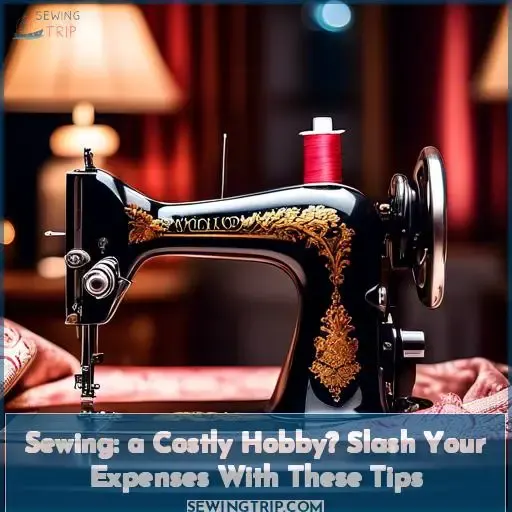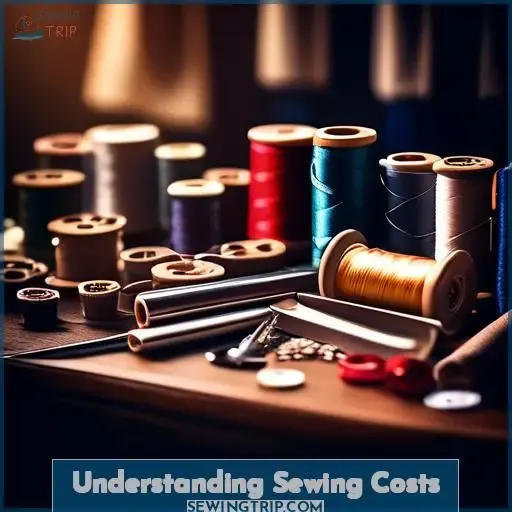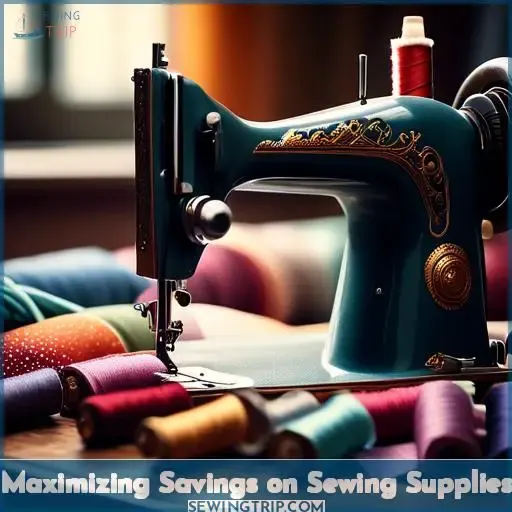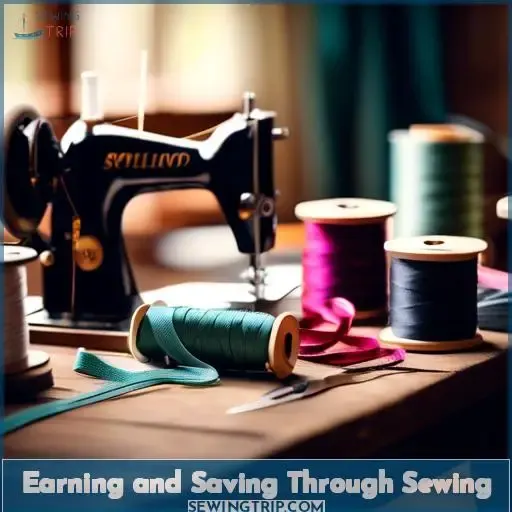This site is supported by our readers. We may earn a commission, at no cost to you, if you purchase through links.
 Diving into sewing, you might wonder: is it an expensive hobby?
Diving into sewing, you might wonder: is it an expensive hobby?
The truth is, while the initial setup and ongoing project costs can add up, savvy strategies exist to significantly cut expenses.
This guide will arm you with practical tips to smartly navigate fabric shopping, machine investments, and more, turning sewing into an affordable passion.
Embrace the freedom to create, master new skills, and enjoy the satisfaction of handmade projects without breaking the bank.
Let’s slash those expenses together.
Table Of Contents
Key Takeaways
- Sewing can be an affordable hobby if beginners start with second-hand machines, hunt for deals on essential tools, and utilize free digital patterns and tutorials.
- Ongoing project expenses can be minimized by sourcing fabric leftovers from thrift stores, sharing patterns, and repurposing old fabrics, thus embracing a frugal approach to sewing.
- When selecting and upgrading sewing machines, starting with a basic model, considering used machines, and saving advanced features for later can help avoid unnecessary expenses.
- Maximizing savings on sewing supplies involves shopping in online marketplaces for secondhand fabrics, taking advantage of clearance sales, and investing in durable tools like sturdy fabric scissors.
Is Sewing an Expensive Hobby
Yes, sewing can be an expensive hobby due to the costs of machines, materials, and tools. However, with budget-friendly strategies like using second-hand materials and waiting for sales, expenses can be significantly reduced.
Understanding Sewing Costs
Embarking on your sewing journey, you’ll encounter initial costs for tools and a reliable machine. As you progress, ongoing expenses for projects and potential machine upgrades will shape your sewing budget.
Initial Setup and Tools
Starting your sewing journey? Keep your wallet happy by snagging a second-hand machine and hunting for deals on essential tools.
Skip the pricey patterns; digital patterns and sewing tutorials online are your new best friends.
And don’t forget, those fabric scraps? They’re gold for practice runs. Remember, the right initial setup doesn’t mean breaking the bank—it’s about smart, savvy choices.
Ongoing Project Expenses
After setting up your sewing station with essential tools, you’ll find that ongoing project expenses can add up.
- Snag fabric leftovers from thrift stores for a song.
- Share patterns with your stitch-savvy pals.
- Hunt for sales on multipurpose patterns and high-quality thread.
- Remember, a frugal budget is your craft’s best friend.
Machine Selection and Upgrades
Choosing your sewing machine is like picking a trusty sidekick. Starting with a basic model is a smart move.
But don’t overlook the charm of a used machine; they come with stories and savings.
Fancy embroidery? Save that dream for later upgrades.
And always, keeping your machine in tip-top shape unlocks those advanced features.
Maximizing Savings on Sewing Supplies
You don’t have to break the bank to indulge in your sewing hobby. Let’s explore how smart fabric shopping, snagging sewing machine deals, and discerning gadget needs can keep your costs down.
Smart Fabric Shopping
After diving into the initial costs of sewing, let’s tackle smart fabric shopping. Scour online marketplaces for secondhand fabrics and recycled materials. Don’t shy away from clearance sales; they’re gold mines for bargains.
Repurposing fabric from old clothes isn’t just savvy, it’s eco-friendly. Remember, a stitch in time saves nine, especially when it comes to snagging deals on materials.
Finding Deals on Sewing Machines
After smart fabric shopping, let’s dive into snagging deals on sewing machines. Think of used machines as hidden treasures in online marketplaces. They’re like finding a diamond in the rough—often just needing a bit of polish (aka servicing) to shine.
Essential Gadgets Vs. Unnecessary Purchases
In the sewing journey, it’s easy to get lost in a sea of gadgets. Here’s how to stay afloat:
- Gadgets to Avoid: Skip the fancy, one-trick ponies.
- Essential Tools: Invest in a sturdy pair of fabric scissors.
- Smart Shopping: Hunt for deals on must-haves.
- Keep It Simple: Remember, the best creations come from skill, not gadgets.
Stay savvy and stitch smart!
Earning and Saving Through Sewing
You can turn your sewing hobby into a profit by selling your handmade items. Repurposing and upcycling fabrics not only saves money but also gives old materials new life.
Selling Handmade Items
After pinching pennies on supplies, why not turn your craft into cash? Dive into the handmade marketplaces and list your creations on Etsy. Hit up local craft fairs or consider consignment shops. Online sales can be a goldmine for the savvy sewer.
Remember, every stitch counts, and your unique pieces could be someone’s treasure.
Repurposing and Upcycling Fabrics
Dive into the treasure trove of your closet and unearth those forgotten fabric scraps and old clothing.
It’s time for a creative reuse revolution! Sustainable sewing isn’t just about saving pennies; it’s a zero-waste quest for freedom in fashion.
Transform those neglected textiles into something spectacular. Remember, one person’s leftover is another’s goldmine for innovation.
Let’s stitch towards sustainability, one scrap at a time!
Budgeting and Planning for Sewing Projects
Setting a sewing budget can be your blueprint for cost-effective creativity. By planning your projects carefully, you’ll minimize waste and maximize your sewing satisfaction.
Setting a Sewing Budget
After exploring how to earn and save through sewing, let’s dive into setting a sewing budget.
- Fabric Sourcing: Hunt for deals like a savvy pirate. Yard sales and online destashes are gold mines.
- Used Machines: Don’t shy away from pre-loved treasures. They often come with stories and savings.
- Project Planning & Budget Tracking: Map your sewing adventures and keep a logbook. This ensures you don’t sail off course financially.
Planning Projects to Minimize Waste
Diving into project planning can be a game-changer in sewing. It’s all about smart choices and a dash of creativity.
| Fabric Selection | Pattern Selection | Project Planning |
|---|---|---|
| Hunt for deals | Reuse patterns | Sketch before cutting |
| Upcycle materials | Mix and match | Estimate fabric needs |
| Swap with pals | Simplify designs | Prioritize projects |
| Test on scraps | Start with basics | Track progress |
| Embrace imperfections | Be flexible | Adjust as you go |
Frequently Asked Questions (FAQs)
How does sewing compare to digital hobbies in cost?
Sewing’s initial costs might pinch your wallet, but it’s a steal compared to digital hobbies that keep you shelling out for the latest tech.
Can sewing improve mental health or reduce stress?
Absolutely, sewing can be a stitch in time for mental health, releasing dopamine for a feel-good buzz and providing a creative escape that can reduce stress and anxiety.
What are the environmental benefits of sewing?
Sewing is like planting a garden in your closet; it nurtures the planet by reducing waste, conserving resources, and promoting slow fashion.
How does the quality of handmade garments compare to store-bought?
Handmade garments often trump store-bought in quality, boasting attention to detail and durability. They’re like a fine wine, getting better with age, while fast fashion can be more hit-or-miss, sometimes unraveling at the seams.
Are there community groups or clubs for sewing enthusiasts?
Yes, there are sewing clubs and groups galore! From local meetups to online communities, you’ll find a patchwork of enthusiasts eager to swap patterns, share tips, and stitch up a storm together.
Conclusion
Dive headfirst into the world of sewing and you’ll find it’s not a wallet-draining vortex, but an affordable adventure!
You’ve got the know-how to shop smart for fabrics, pick the right machine, and dodge unnecessary gadgets.
Sell your creations, upcycle with flair, and plan meticulously to keep costs down.
Keep stitching and watch your bank balance—and your skills—grow!









